ASUS Maximus Formula SE: X38 and DDR2 Unite!
by Rajinder Gill on November 9, 2007 7:00 AM EST- Posted in
- Motherboards
Air-Cooled and Subzero Benchmarks
ROG boards are designed to be raced (the extreme voltage ranges in BIOS hint at this), after "realist" testing. Any performance review is incomplete without taking at least a small benchmarking test drive with the pedal to the metal. We decided to find out just what the board would do with a "handpicked" E6850 CPU that is capable of high FSB speeds. Using air-cooling we managed to boot at 550FSB (3.85GHz), but did not manage to hold Super PI 32M stable using the 400 strap and 1:1 divider with 4-4-4-10 memory timings. We settled for 540FSB (3.78 GHz), again with the 400 NB strap using the 1:1 divider. Here are a few benchmark results:
E6850
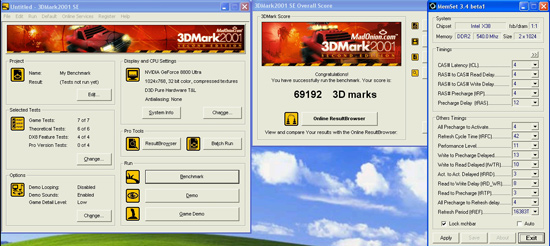
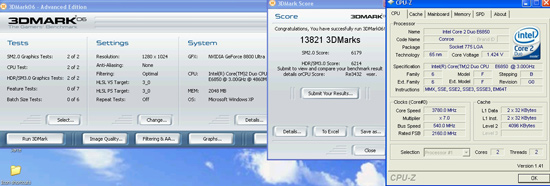
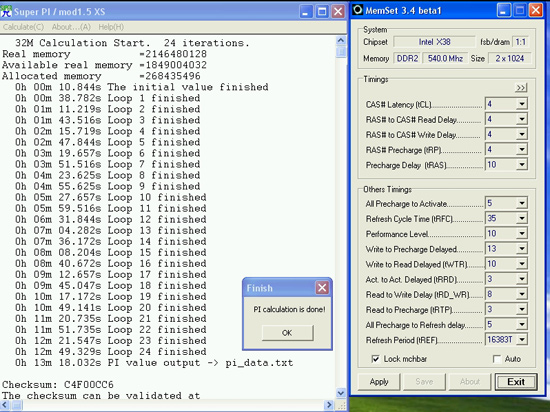
Using cascade cooling on both the CPU and GPU allowed benching in the region of 550-560FSB using the 9x multiplier. tRD (Performance Level) had to be set quite loose at 11-12 to provide stability for the benchmarks to pass. This is another area where ASUS is implementing core BIOS level changes to improve stability and memory performance in the higher FSB ranges. The DFI P35 board also reached 550FSB with this CPU but we were not able to hold the 550FSB level over the course of testing. We had to back off to the 540FSB range. This is the one key difference we have noticed between the two chipsets, the X38 will hold a higher FSB level over the course of extreme benchmarking than the P35.
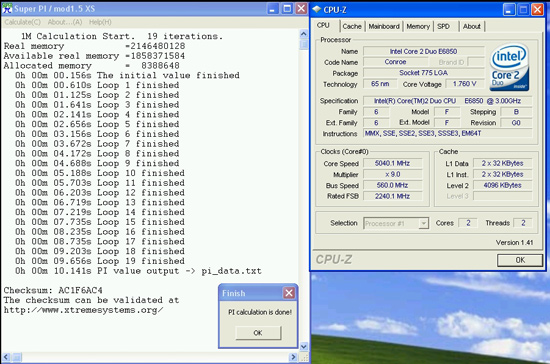
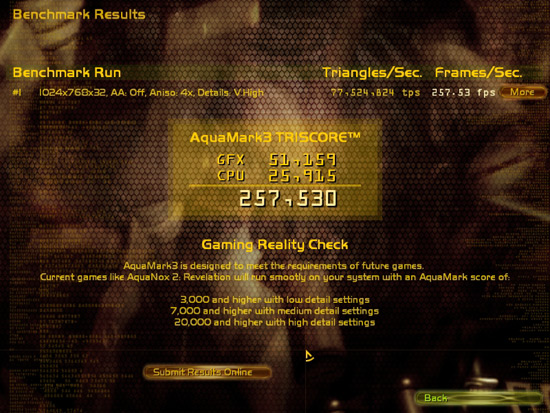
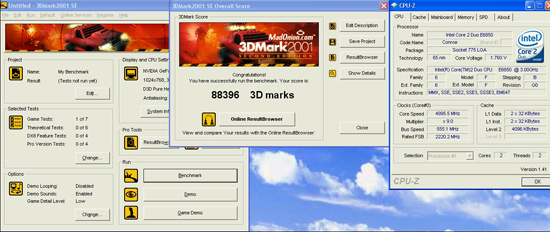
QX6800
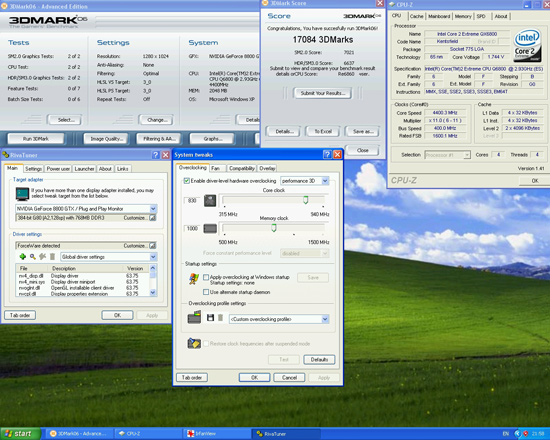
The Maximus Formula is certainly capable of holding high FSB/CPU MHz levels for extreme benchmarking. We also gave our cold bugged QX6800 G0 a little test spin with four cores active for a 3DMark06 session; unfortunately we were limited to around a 4400MHz CPU speed. This is not a problem with the motherboard; the CPU itself has been tested on many different boards with the same CPU MHz wall. These results surpass our DFI P35 slightly, indicating to us that the X38 is finally starting to mature and this board is a solid choice for overclocking, especially with a dual-core processor.
| ASUS Maximus Formula Overclocking Testbed |
|
| Processor | Intel Core 2 Duo E6850 - G0 Stepping Dual Core, 3.0GHz, 4MB Unified Cache, 9x Multiplier, 1333FSB |
| CPU Voltage | 1.300V Base |
| Cooling | Various - Tuniq Tower, Dual Rotary Cascade |
| Power Supply | PCP&C 1200W |
| Memory | OCZ Flex PC2-9200 (2x1GB) |
| Memory Settings | 4-4-4-12 (DDR2-1066) |
| Video Cards | MSI 8800 Ultra @ 702/1205, EVGA 8800 GTX 830-861/1000 |
| Video Drivers | NVIDIA 163.75 |
| Hard Drive | Western Digital 7200RPM 250GB - WD2500KS |
| Optical Drives | Plextor PX-755A |
| Case | Dimastech benching table |
| BIOS | ASUS 0505 |
| Operating System | Windows XP Professional - SP2 |
| . | |
ROG boards are designed to be raced (the extreme voltage ranges in BIOS hint at this), after "realist" testing. Any performance review is incomplete without taking at least a small benchmarking test drive with the pedal to the metal. We decided to find out just what the board would do with a "handpicked" E6850 CPU that is capable of high FSB speeds. Using air-cooling we managed to boot at 550FSB (3.85GHz), but did not manage to hold Super PI 32M stable using the 400 strap and 1:1 divider with 4-4-4-10 memory timings. We settled for 540FSB (3.78 GHz), again with the 400 NB strap using the 1:1 divider. Here are a few benchmark results:
E6850



Using cascade cooling on both the CPU and GPU allowed benching in the region of 550-560FSB using the 9x multiplier. tRD (Performance Level) had to be set quite loose at 11-12 to provide stability for the benchmarks to pass. This is another area where ASUS is implementing core BIOS level changes to improve stability and memory performance in the higher FSB ranges. The DFI P35 board also reached 550FSB with this CPU but we were not able to hold the 550FSB level over the course of testing. We had to back off to the 540FSB range. This is the one key difference we have noticed between the two chipsets, the X38 will hold a higher FSB level over the course of extreme benchmarking than the P35.



QX6800

The Maximus Formula is certainly capable of holding high FSB/CPU MHz levels for extreme benchmarking. We also gave our cold bugged QX6800 G0 a little test spin with four cores active for a 3DMark06 session; unfortunately we were limited to around a 4400MHz CPU speed. This is not a problem with the motherboard; the CPU itself has been tested on many different boards with the same CPU MHz wall. These results surpass our DFI P35 slightly, indicating to us that the X38 is finally starting to mature and this board is a solid choice for overclocking, especially with a dual-core processor.










24 Comments
View All Comments
jozeaphe - Sunday, February 17, 2008 - link
Hi Guys i Just Build a new PC :Asus Maximus Formula SE .
Intel Core 2 Duo E8500 .
2 GB Ram - 800 MHz ( for the moment ) .
can any one help to overclock my PC to Max settings within the following :
1. Stock Intel CPU heatsink\fan ( come with processor ) . No water cooling on the northbridge .
2. Stock Intel CPU heatsink\fan ( come with processor ) . With water cooling on the northbridge .
3. The above 2 options but using 2 GB Ram - 1066 ( if thats make a difference ) .
And Thank u All , Jozeaphe@gmail.com .
guitronics - Wednesday, February 13, 2008 - link
I don't know if I have an 'SE',but I have the game Stalker.These Mobo's are NHRA Top Fueler's, not 18 wheeler's. They're Gaming 'Boards,not workstations,or servers.Their cause is overclocking/tweaking. So:Some legacy stuff hadda go...serial and parallel:Buy a PCI card,if you really need it.There are plenty of pci slots.No Esata? There are 6 Sata,and 1 IDE port.2 -GB Lan options.Yes,it does ECC:But why does a gamer want that?There are 1394a ports,not 800 Mhz.Or,at least that speed isn't documented.The USB mouse...it's time to get on the "dump legacy stuff" wagon.How big a deal is that?Up to 8 GB of memory,and onboard 0,1,5;and 10 Raid support.Put a Blu-Ray on the IDE,run raptors' in raid 0, still have room for > 4 < More drives....Terabyte's, anyone?A good case and you can swap 'em out...no big deal."It's a Gaming Machine"!
jay401 - Tuesday, November 13, 2007 - link
I think we've officially reached the point of option saturation, where there are literally TOO many options in the BIOS for most overclockers to ever care about. Sure, it's great for the handful that will actually make use of all of those options, but we're getting dangerously close to the point where it is TMI.RFV - Wednesday, November 21, 2007 - link
you'd love the DFI BIOS!RFV - Tuesday, November 13, 2007 - link
I have read that the Asus Maximus Formula SE is now "End Of Line" so you better hurry if you want to purchase one. Asus did the same thing with the Blitz Formula SE, so this is not suprising news, the Maximus Formula SE was always going to be a limited edition board from the get go. Also, fom the reviews I have read on this board from people who upgraded from P35 boards is that the Maximus Formula SE X38 board required more volts than the Asus P5K Deluxe board to reach the same overclock. They also reported that the X38 boards generally ran hotter than the P35 boards at the same overclock.457R4LDR34DKN07 - Monday, November 12, 2007 - link
Thanks for the in depth bios descriptions, it has helped me dramatically increase stability while using patriot pc8500 memory.Etern205 - Saturday, November 10, 2007 - link
What happened to the Maximus Extreme?Raja Gill - Sunday, November 11, 2007 - link
that's nextzoom314 - Saturday, November 10, 2007 - link
I wonder does Asus still have Locked Multipliers on Extreme cpus still like they do on the P5W DH Deluxe? Meaning any multiplier above the Default Multiplier is locked off to prevent users from overclocking, rendering an Extreme Dual/Quad cpu an Expensive Normal Dual Core or Quad Core cpu(A QX6700 becomes a Q6700 cpu). Of course one can adjust the Multiplier downwards to 6 as Asus say No one needs those upper Multipliers and Hence Asus does Not Support Extreme any cpu!!!!Raja Gill - Saturday, November 10, 2007 - link
the upwards multipliers work fine on this board...